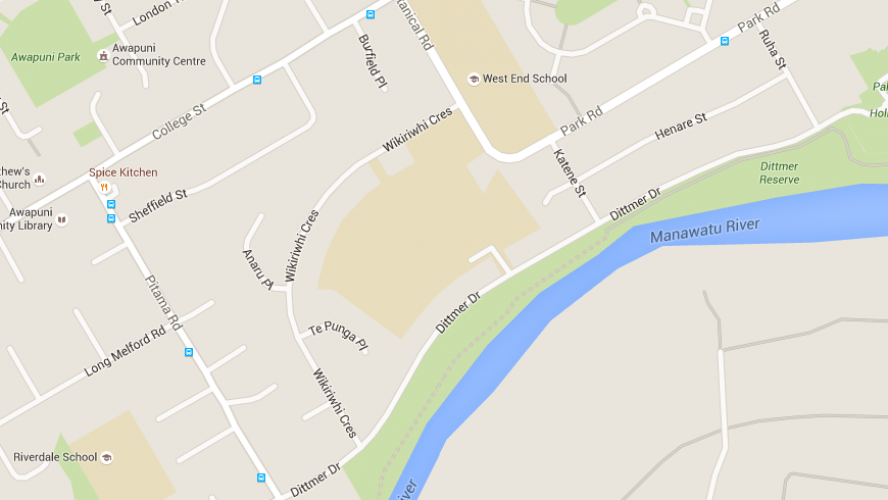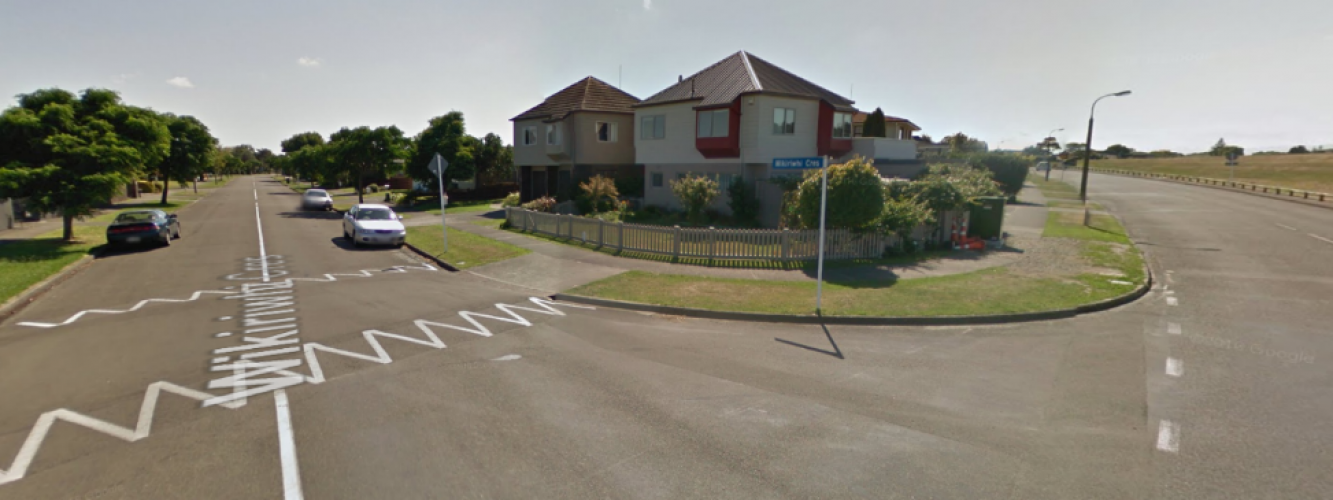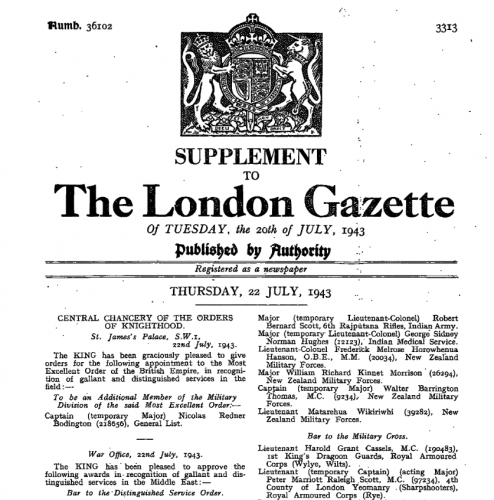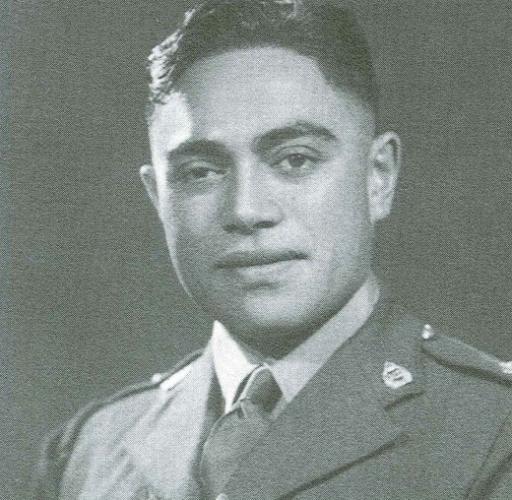090 Wikiriwhi Cres Palmerston North, street view from the corner of Dittmer Drive.
Reason for the name
As part of the process of subdividing and naming streets, George Dittmer was contacted in late 1964 to give his thoughts on the naming of streets after 28th Māori Battalion soldiers as a commemoration of their service to their country. It was decided that one of the streets would be named Wikiriwhi Crescent, after Distinguished Service Order (DSO) and Military Cross (MC) recipient Captain Matarehua Wikiriwhi.
Prior to its subdivision, the land known as Awatapu was a golf course and grazing area situated next to the Manawatu River. In order to free up land for residential development and increase revenue, a Council meeting of 16 April 1963 resolved to subdivide the area via “disposal of sections through Land Agents at pre-determined figures fixed by the Council”. The new Awatapu College had to be allowed for, and the old Awatapu Golf Links shifted upstream to Brightwater Terrace, which then became the Palmerston North Golf Club.
Council Meeting minutes of 7th October 1964 when it was decided to name the streets of the Awatapu Subdivision in commemoration of the individuals of the 28th Māori Battalion from a list provided by the Lieutenant Colonel Dittmer. Captain Wikiriwhi is the second name listed. Source: Ian Matheson Archives, Town Planning Committee Minute Book, Series 1/1/7, Volume 5.
Over the years after the naming of Wikiriwhi Crescent there were numerous attempts by citizens to have the street renamed, most due to mispronunciation. The Palmerston North Council always upheld its original decision. Source: Ian Matheson Archives, Town Planning Committee Minute Book, Series 1/1/7, Volume 5.
As part of the process of subdividing and naming streets, George Dittmer was contacted in late 1964 to give his thoughts on the naming of streets after 28th Māori Battalion soldiers as a commemoration of their service to their country. Dittmer provided a comprehensive list of soldiers who had served under him which was later utilised by the Council to adopt further street names in the Awatapu subdivision. After consultation and further correspondence with the Palmerston North City Council it was decided that one of the streets would be named Wikiriwhi Crescent, after Distinguished Service Order (DSO) and Military Cross (MC) recipient Captain Matarehua Wikiriwhi. The resolution was passed by Council on 22 November 1965 and took effect from 1 February 1966.
Wikiriwhi Crescent is located in a mainly residential area and acts as the secondary thoroughfare for the area. It begins in the east and runs off Botanical Road, curving gently around the entirety of Awatapu College to the south. Other streets named after 28th Māori Battalion soldiers which run off Wikiriwhi Crescent are Anaru, Te Punga and Wharite places. Wikiriwhi Crescent ends at Dittmer Drive alone the Manawatu River.
Author: Evan Greensides, Research Assistant for Palmerston North City Library.
Captain Matarehua Wikiriwhi
Matarehua “Monty” Wikiriwhi born on the 4th April 1918 in Whakarewarewa, the youngest child of Eruera and Miriama Wikiriwhi, both of Tuhourangi decent. He was educated at Whakarewarewa Māori School where he won a Makarini Scholarship which took him to Te Aute College, Hawke’s Bay. He eventually journeyed to the East Coast where he became a shepherd on the 'Te Po' station at Whangaparaoa.
Matarehua was there when war was declared and enlisted with 'C' Company of the 28th Māori Battalion. However, while in camp at Palmerston North Captain Rangi Royal recognised him as a Rotorua local and promptly claimed him for 'B' Company. Matarehua, except for when he returned to 'B' Company for the Italian Campaign, served most of his time with the Intelligence Section of Battalion Headquarters.
Matarehua left for Europe with the Second New Zealand Expeditionary Force, 2nd Echelon in 1940. After participating in the withdrawal through Greece, Matarehua was part of the 2nd New Zealand Division which was evacuated to Crete, whereupon he witnessed the initial landings and vicious fighting on the first day of the invasion on 20 May 1941. In the 28th Māori Battalion logbook he wrote:
0830 hrs. - It appears that the invasion is about to be launched. The area round the aerodrome is being most intensively bombed and machine-gunned by countless planes of all kinds. Clouds of dust are rising high into the sky turning the whole area into a real inferno of flying dust and metal and visibility was reduced almost to nil. In the midst of all this pandemonium paratroops were dropped round the aerodrome.
0915 hrs. - A further batch of paratroops disgorged in the aerodrome area. About 200 troop-carrying planes have now passed along the Agha valley and made their way out to sea flying about 10 ft. off the water. We estimate that 800–1000 troops have been dropped round the aerodrome with about the same number dropped in the valley of Agha.
1030 hrs. - One troop-carrying plane effected a landing on the beach opposite D Coy lines. It was immediately set on fire presumably by Bren gun fire.14 of these enormous black troop-carrying planes are circling round and round the beach and above the aerodrome seeking landing places. A glider landed on the beach about 200 yards ahead of the plane already on fire.
After the Battalion participated in the unsuccessful attack on Maleme Airfield, a fighting withdrawal was undertaken to Suda Bay where the Battalion was evacuated to Egypt.
After a period of rest and reorganisation Matarehua was again on the move with the Battalion, this time to Mersa Matruh and the start of an 11 month campaign. After settling into the Alamein Line in July 1942, the Battalion was near or at the front line for most of the proceeding time. As the Afrika Corps prepared to attack, Matarehua wrote, “it is pretty nerve racking business to sit down at the receiving end of artillery big guns”.
While the Battalion deflected Rommel’s last major advance into Egypt, then counterattacking via Montgomery’s Supercharge offensive which would take them to Tripoli, Matarehua would have seen his men taking constant casualties. It was such casualties that resulted in Matarehua being given charge of the Battalion during the battle for Takrouna. The citation for the Distinguished Service Order (DSO) Matarehua received for his actions during the battle reveal his skill and experience:
In the attack on Takrouna village on the night 19/20 April 1943 Lieutenant Wikiriwhi, Intelligence Office of his unit was personally responsible for the reorganisation of his Battalion during an extremely difficult period of the attack. In the course of the attack his unit suffered heavy casualties including his Commanding Officer, adjutant and the whole of the officers of the two forward Companys. Undaunted however, Lieutenant Wikiriwhi with a quick grasp of the situation pushed on with the attack and with cool deliberation, courage, determination and with complete disregard for his own personal safety and despite fierce enemy shell, mortar and machinegun fire he set about the further task of reorganising the Companys, establishing and consolidating them in fixed positions and establishing Battalion Headquarters.
First light on 20 April 1943 found the Battalion in a difficult situation. There was no communication with Brigade Headquarters, all Company Commanders had been wounded and evacuated and the hard fighting during the night had caused considerable disorganisation. The area had been subjected to heavy mortar and artillery fire. Lieutenant Wikiriwhi assumed command of the Battalion, completed the reorganisation of the Companys, and consolidated the ground won. Until relieved at 1400 hours he carried out the triple role of Commanding Officer, Adjutant and Intelligence Officer.
Throughout the entire action Lieutenant Wikiriwhi displayed coolness under fire, and the firmness, initiative and judgement of an experienced soldier. His continual cheerfulness, calm and complete disregard of enemy fire inspired his unit during a very difficult and dangerous period. Only when satisfied that the situation was stabilized and a senior officer available to take over from him did he relax his efforts. He then reported personally to Brigade Headquarters.
After reporting to Brigadier Kippenberger the next day, he was promoted to Captain and oversaw the Battalion until Captain Pene, the only other surviving officer, was brought up from B Echelon.
While Crete and Africa were a vigorous test of the 28th Māori Battalion’s fighting capabilities, it was in Italy where their toughest tasks were to be set. After first resting at Port Said in Egypt, Captain Wikiriwhi joined the 22,000-strong New Zealand Division sailing for their new base at Taranto on 5th October 1943. By early December they had crossed the Sangro River and aimed for their first clash on mainland Europe at Orsogna. The month long battle along the river was only a prelude to the main clash coming at Cassino. Matarehua took part in the grinding fight around the railway station there, the events of which are well-documented in the 28th Māori Battalion diary:
13-14 February 1944: As we closed my 12 Pl on right wavered momentarily in the face of a particularly violent burst of MG fire from 2 Jerry posts. I immediately ordered a charge—the men leapt forward and, as in training, two men leapt on to the wire (concertina)—the others jumped over (there was sufficient light from flares and gun flashes) and, with bayonet and grenades cleaned the posts out. Others were busy with wire cutters on the ordinary dannert wire and the platoons were soon through on to the 1st objective.
While the battle raged back and forth, Matarehua commanded his men admirably, all the while being wounded twice by shrapnel, a piece of which shattered his leg:
19th February 1944: ...Capt. Wikiriwhi who had managed to crawl back in spite of his severe wound. He propelled himself back with the aid of two pointed sticks and thus he managed to return back taking all day and night. A very meritorious incident, catching the praise and admiration of the whole division. He was evacuated to ADS. Many messages of praise and admiration received for him."
For his actions, Matarehua was awarded the Military Cross (MC) and evacuated to England. While convalescing in Burwood Hospital, Matarehua and others from the Battalion were visited by Charles Upham, VC & Bar who had graduated from Lincoln College and who recommended Matarehua to take a course there. This he did after the war, and graduated as a Rural Valuer with a Diploma in Farm Management. His qualification led to his employment by the Māori Affairs Department as a Farm Supervisor at Ruatoki, Whangarei and Pukekohe. He later joined the Welfare Staff of Māori Affairs in Auckland, the position which he retired from in 1976.
In spite of constantly recurring trouble with his leg Matarehua was ever the sportsman, excelling particularly in table tennis and golf. In the latter game, he managed to reduce his handicap down to single figures. He was also a Rotarian in his Pukekohe days. He was an enthusiastic member of the Wingies & Limbies Association, as well as being intimately concerned in Māori and RSA activities. He was Honorary Secretary of the Māori Battalion Association at its inception in the 1950's.
Matarehua Wikiriwhi died on 29th October 1988 aged 70, and was buried with full military honours in the Soldiers' Plot of Rotorua Cemetery.
Honours and Awards
- Companion of the Distinguished Service Order (DSO)
- Member of the Order of the British Empire (MBE)
- Military Cross (MC)
- 1939-1945 Star
- Africa Star (8th Army clasp)
- Italy Star
- Defence Medal
- War Medal 1939-1945 with oak leaf
- New Zealand War Service Medal









